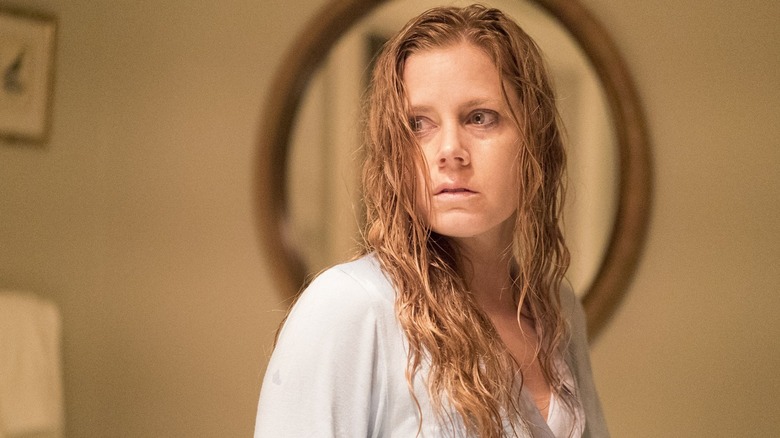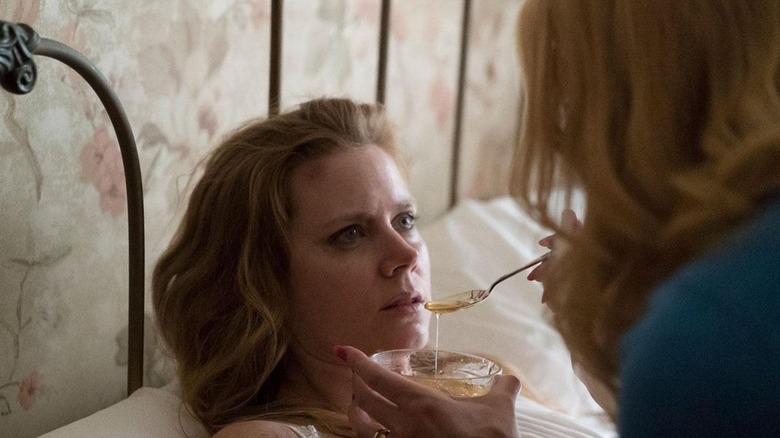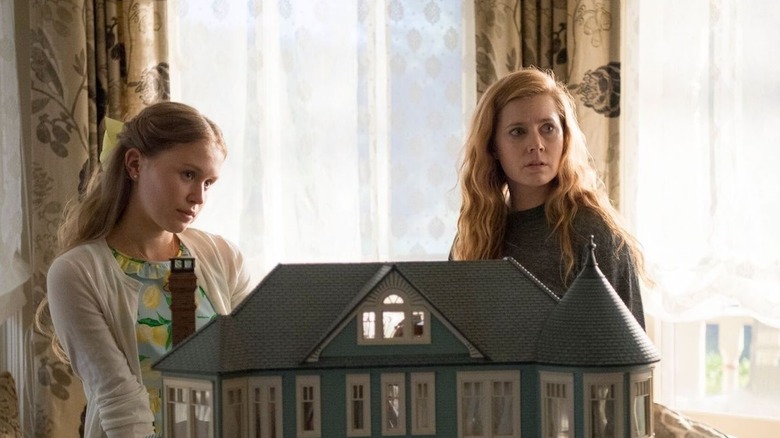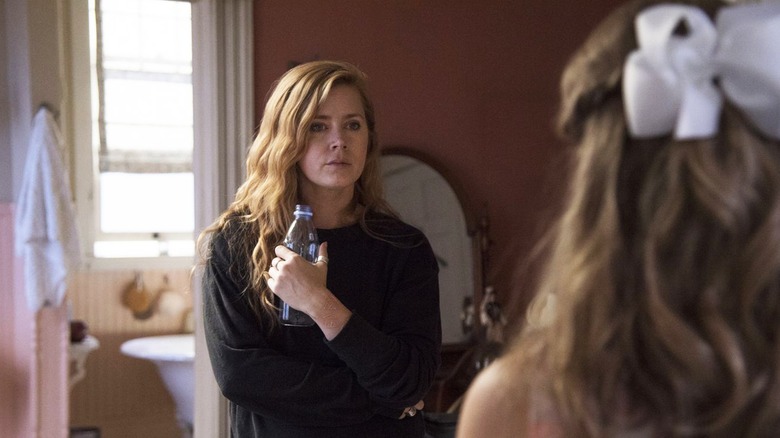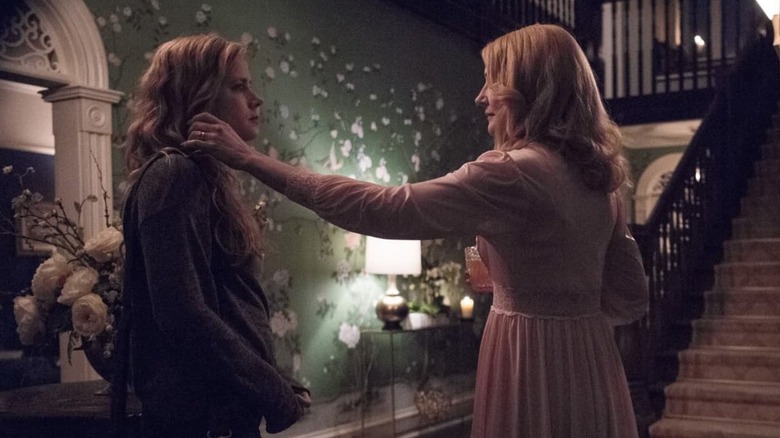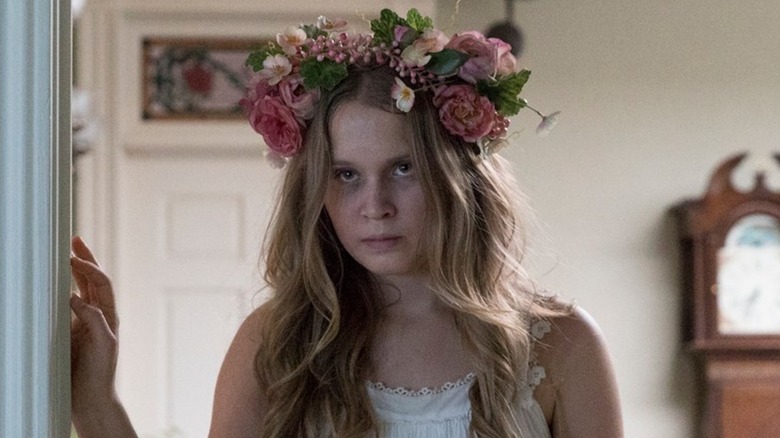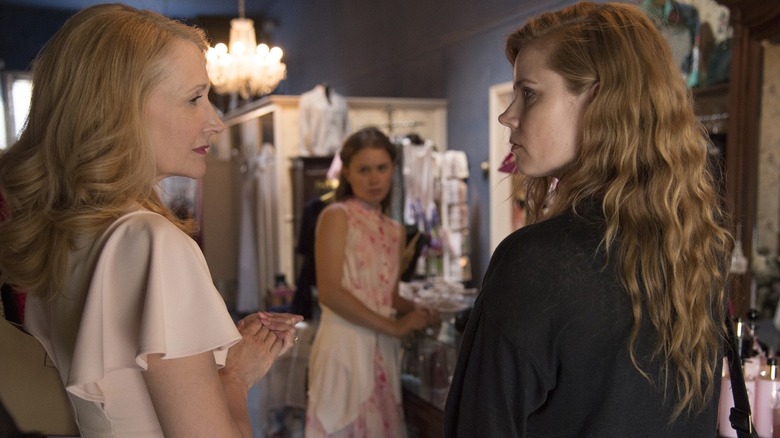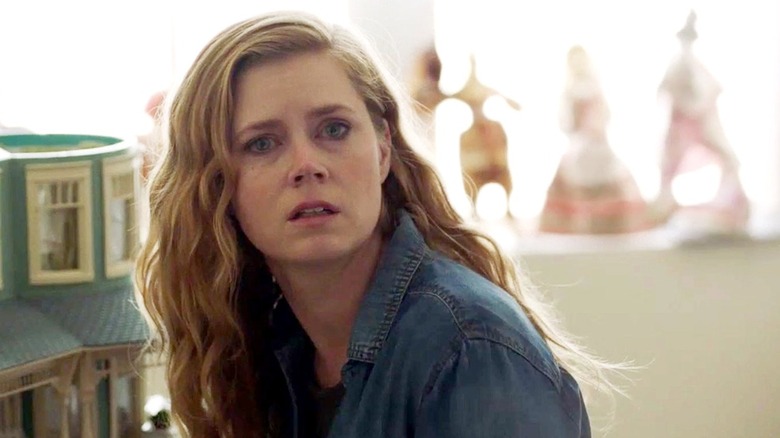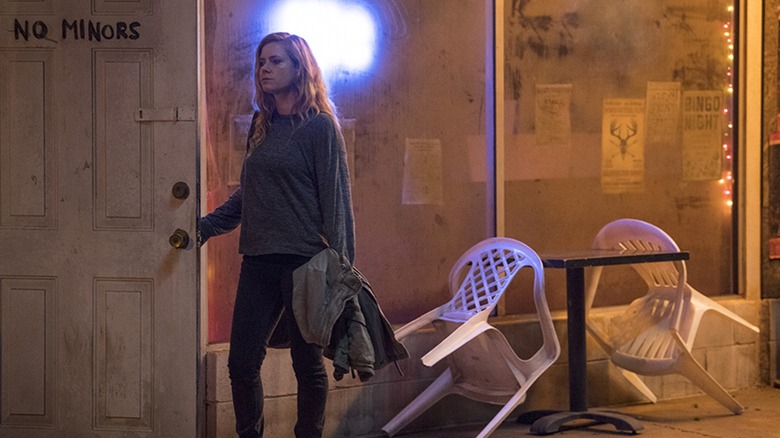Sharp Objects Ending Explained: The Truth Hurts
We may receive a commission on purchases made from links.
It's Gillian Flynn's world and we're all just living in it. When "Sharp Objects" premiered on HBO in July 2018, both "Gone Girl" and "Dark Places," her second and third novels respectively, had already been adapted into film. "Gone Girl" was a critical and commercial success, though "Dark Places" was decidedly less so, sitting at a grim 23% score on review aggregator Rotten Tomatoes. "Sharp Objects" is undoubtedly her nastiest piece of work, and with the prestige HBO treatment, fans were eager to see how it would all shake out. In short, it was a masterpiece.
"Sharp Objects" was patient where most crime thrillers were errant, probing where most cut to black. It was a tapestry of broken people, broken dreams, and horrific murders, all of which orbit around Amy Adams' Camille Preaker, a reporter with a history of self-harm and one of the genre's most textured characters ever. She's drawn back to her hometown of Wind Gap, Missouri to investigate a series of child murders distressingly linked to her own family. Whether read or seen, the twist, so to speak, is simultaneously obvious and heartbreakingly, disturbingly unexpected. Camille's half-sister Amma (a sensational Eliza Scanlen) was behind the slayings, lashing out after years of repeated traumas. It's a beguiling twist, and here, we'll be unpacking what it all means, both within the context of the show and the wider body of Gillian Flynn's work.
What you need to remember about Sharp Objects
Camille Preaker, a functioning alcoholic (a captivating Amy Adams in one of her best performances ever) is corralled back to her hometown to investigate the murder of a young girl, 13-year-old Ann Nash. 14-year-old Natalie Keene is also missing, and reasonably, the residents of Wind Gap fear foul play there as well. Upon arrival, Camille is met with both hostility and warmth. Some, like proxy maternal figure Jackie (Elizabeth Perkins) are thrilled to see her back. Others, like Camille's own mother, Adora (Patricia Clarkson, winning a Golden Globe for the role), are antagonistic, hinting at years of hidden abuse and abhorrence.
Shortly after Camille arrives, Natalie Keene's body is discovered, her teeth removed. Camille's editor is convinced Camille is perfect to cover the story, insisting she stay until the killer is apprehended. For eight episodes, Camille contends with her traumatic family history– including a younger sister, Marian, who passed away, new step-sister Amma, and, of course, Adora — not to mention her own mental health crisis, most notably a history of self-harm, and an actual killer targeting young girls.
As the finale begins, Adora is close to killing both Camille and Amma. Suffering from Munchausen syndrome by proxy, she was responsible for Marian's death and is close to being responsible for two more. She's apprehended, charged, and convicted for the two other murders. Case closed. Until that final scene. Camille catches Amma, recognizing what she's done as another body is found. "Don't tell mama," she murmurs before the credits roll.
What happens at the end of Sharp Objects, and is Amma the killer?
Camille Preaker is near death. Adora has been slipping her rat poison. Amma is also ill, but over the years, she's built up a tolerance. Camille is deliberate in her suffering — if someone arrives in time, they can test her system and solidify Adora's involvement in Marian's death years before. Luckily, hot cop Richard (Chris Messina) manages to intercede. Camille and Amma are saved, and a pair of bloody pliers are found on the property, sufficiently linking Adora to the deaths of both Ann and Natalie. She goes away, Camille returns home and takes over the care of Amma as a surrogate mother.
Amma's behavior is odd, a little jealous. She's especially hostile toward new friend, Mae (Iyana Halley), a hostility that swells the more Camille takes an interest in Mae. It's innocuous, but Amma can't distinguish between it. Mae's mother arrives, asking if Camille or Amma have seen her. No, but Camille is happy to check with Amma. She enters her room, finding Amma playing with her signature doll house. The floors, makeshift ivory to match Adora's, look a lot like teeth. Camille's face falls, petrified. Amma, as noted before, famously says, "Don't tell Mama." The screen cuts to black, though as the credits roll, there are brief, shocking flashes of Amma and her friends killing Ann alongside solo flashes of Amma killing both Natalie and Mae. Adora did kill her daughter, but those other dead girls were all Amma's doing, and she's taken their teeth as trophies — perfect to line the floor of her doll house.
Violence begets violence in Sharp Objects
Amma is conspicuously infantilized throughout the duration of "Sharp Objects." Her adult behavior — drug use, alcohol consumption, flirting with older men — is embellished, means by which she can regain the control being eroded at home. When she's ill, Adora dresses her like a doll, insistent upon taking care of her. If she objects, Adora lashes out, often threatening to withhold love and attention. Camille is Amma's only lifeline, and when both are rescued in the finale, it's a singular bright spot in a series defined by tragedy and distinctly female violence.
In an interview with Rolling Stone, writer Gillian Flynn remarked, "You want to give enough time where Amma and Camille are being like sisters so that it is that moment of incredible shock." In the novel, the fallout is given time to breathe. Camille relapses, though she is saved and recovers, being cared for by a de facto parental figure for the first time in her life. The adaptation, of course, ends on a much grimmer note. In that same Rolling Stone interview, Flynn remarks making the decision with an "evil laugh." Evil, indeed.
Gillian Flynn's body of work focuses on female violence
Gillian Flynn's work is regularly met with controversy. It's small scale, limited most often to cultural critics or literary fiends, but of chief concern is the way in which Flynn not only depicts violence, but singular female violence. "Gone Girl" famously subverts expectations, revealing that ostensible victim Amy Dunne isn't just alive but a mastermind who has successfully framed her husband for her death. Emine Saner's piece for The Guardian assessed the contemporaneous reception where some critics decried "Gone Girl" as anti-feminist, though Flynn famously remarked in another interview with The Guardian that feminism also includes "the ability to have women who are bad characters."
Motivation is key to Flynn's writing. Her characters are not incidentally bad. Any alleged shallowness conceals a depth of past traumas and experiences that inform who her women are in the present day. Camille is richly developed, both on-screen and in the subtext that tethers one beat to another. Amma as the killer is shocking, yes, but it also speaks to the legacy of generational violence, particularly maternal violence, and the endurance of the wounds afflicted therein. The women in Flynn's writing transcend crime fiction tropes and standards, offering distinct points of view too often restrained or outright ignored in popular genre fiction. "Sharp Objects" might be the best of the bunch, and its ending feels like an appropriately brutal knife to the gut.
Is Amma born evil?
For centuries, behavioral scientists have questioned whether someone is born violent or made to be that way. In fact, Netflix's "Mindhunter" is a whole series about that very question. So much of the true-crime boon we're experiencing is principally rooted in that inquiry. Audiences fear the things they don't understand, so time and time again, they delve deep into the darkest parts of humanity, desperate to cull anything even remotely resembling an answer. The brilliance of "Sharp Objects," and of Amma as a character specifically, is that from her first appearance in the series, she could reasonably be the killer. As originally conceived by Flynn, then later brought to life by Eliza Scanlen, Amma possesses mature, sinister machinations from the start.
The twist has less to do with whether Amma could be the killer and more to do with whether the audience could accept it. "Sharp Objects" doesn't have the moral murkiness of "River's Edge" or the tragedy of "Mare of Easttown," another HBO crime series. Amma wasn't just a killer — she was brutal. As we see in the post-credit scenes, Amma violently murdered three girls (Mae, Ann, and Natalie) and seemed to thoroughly enjoy it. She pulled teeth and choked young girls out with wire as they pleaded for their lives. It wasn't an accident or a mistake — it was deliberate. While the novel focuses less on Amma in the dénouement and more on Camille's recovery, the nature of the crime remains perennially haunting. Could it have been stopped? Was it always meant to be? Flynn deliberately withholds those answers because she doesn't know better than the rest of us, and that's the most chilling thing of all.
The nature of Sharp Object's characters
In an interview with Entertainment Weekly, Amy Adams remarked, "I've never been afraid to explore. I just typically play characters who have more effective masks, and I think Camille just doesn't have a very effective mask." Masking, rooted in a kind of social performativity whereby persons camouflage natural behaviors or traits, is core to the innate tragedy of "Sharp Objects." In conventional crime shows, the audience is principally tasked with seeing beyond the mask, the idea that everyone has a secret and the audience needs to deduce what it might be. Not so here. Camille, Amma, and Adora — the trio of broken, possibly dangerous women — make no qualms about showing who they are.
The series' most violent twists — Adora killed her daughter, Amma killed her friends — aren't just foreshadowed, they're spotlighted. Adora's ceaseless cruelty toward Camille manifests the moment the latter arrives at the former's home in the premiere. Amma never once shows anything remotely resembling grief toward the death of her friends. In an interview with Collider, Eliza Scanlen remarked, "Amma confuses me, so trying to decide how I was going to go about the scene was difficult sometimes because there are just so many different versions of the truth with Amma." Masking is a hallmark of crime and genre media, though in "Sharp Objects," those masks are off. For what feels like the first time, audiences get to see these characters — these fundamentally fractured, damaged characters — exactly as they are.
The ending of Sharp Objects is a devasting rug pull
For peace of mind, fans might have wanted "Sharp Objects" to end differently than it did. In fairness, the quick cut to black after the reveal is, broadly speaking, a little cruel. It's a rug pull with no time for recovery. It makes for good television, if not necessarily satisfying television. Still, Gillian Flynn has been clear that there was no other option. "Never once," she remarked in an interview with Rolling Stone, was there any other ending considered. She added, "My thought is, if you've read the books and you've committed to seeing a version of that book, I'm not interested in changing it just because you've read the book."
It's a perennial struggle in page-to-screen adaptations. Stray too much, you risk alienating the built-in fan base. Stray too little, audiences wonder what the point of adapting it at all was. Why not, in other words, just read the book? Flynn, at least, managed to satisfy fans both old and new. For fans of the source material, that rug pull hurt, not because of what happened, but because of how little time there was to process it all. For new fans, it amounted to an incredulous, exhilarating gasp. That's how this ends? Indeed, it is. And with it, Flynn and company cemented "Sharp Objects" as not just the premier adaptation of Flynn's own work, but a premier example of crime television generally. It's a chilling, haunting masterpiece.
Dark Places on Max
Fans of Gillian Flynn's work were likely thrilled to see that "Dark Places," Flynn's first novel, would be getting the prestige HBO treatment too. Announced in January 2024, Flynn will be taking a more active role this time, serving as a co-creator, co-showrunner, and writer for the new series. The hope, of course, is that audiences will forget that 2015 feature adaptation.
While "Dark Places" isn't Flynn's strongest work, the success of "Sharp Objects" bodes well. If the new series can come anything close to matching the macabre menace of the latter, then there's little doubt "Dark Places" will be the latest in a long line of must-see-TV. It is, however, worth noting that a huge part of "Sharp Objects'" success was rooted in the late Jean-Marc Vallée's direction. Vallée singularly focused on the horror undercurrents of Flynn's writing, no doubt attributing to "Sharp Objects'" success as, really, a horror series. The quick cuts, startling acts of violence, and simmering midwestern heat paying homage to Tobe Hooper — it was all there. Whether "Dark Places" follows suit remains to be seen, but with "Sharp Objects" being Vallée's standout directorial work, it's going to be a tough act to follow.
